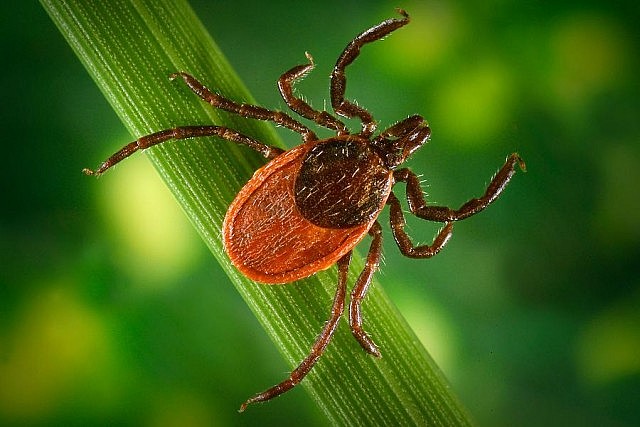
In the wake of Canadian pop star Avril Lavigne’s disclosure of her struggle with Lyme disease, a local health unit is encouraging local residents to take precautions against blacklegged ticks that can spread Lyme disease.
Lavigne recently revealed how she has been debilitated by the effects of Lyme disease, which she believes she contracted from a tick when during a visit to her hometown of Napanee in the spring of 2014. She began experiencing headaches and fever within days. As her symptoms worsened, Lavigne saw several doctors and specialists who were unable to help her. By the fall, she was bedridden.
Because the early symptoms of Lyme disease are non-specific (headache, fever, muscle and joint pain, and fatigue) and blood tests for the infection are unreliable, people with Lyme disease are commonly misdiagnosed.
It wasn’t until Lavigne saw a Lyme disease specialist that she was properly diagnosed and began to receive the proper treatment. After several courses of antibiotics and months of rest, she says she’s now finally starting to recover.
Avril Lavigne Opens Up About Her Struggle With Lyme Disease
Blacklegged ticks, also known as deer ticks, that have been infected with the Borrelia burgdorferi bacteria are the only ticks that spread Lyme disease. Due largely to climate change, blacklegged ticks are spreading into more populated areas.
Richard Ovcharovich, Manager of Environmental Health with the Haliburton, Kawartha, Pine Ridge (HKPR) District Health Unit, explains that the risk of an infected tick spreading Lyme disease to a person is relatively low — but it’s best not to take any chances.
“Lyme disease can be very devastating to a person, so you should be watchful for blacklegged ticks when camping, fishing, hiking, and being active outdoors,” he says. “The best advice is to get tick smart. Know the bug, know the bite, and know what to do.”
Blacklegged ticks are small and cannot fly, so they settle on tall grasses and bushes until they can attach themselves to a passing person or animal. The tick then feeds on their host’s blood and, if infected with the bacteria, may transmit Lyme disease to their host.

“Ticks are more likely to transmit infection to a person after being attached for more than 24 hours of feeding,” Ovcharovich notes. “That makes the prompt detection and quick removal of ticks one of the key methods to prevent Lyme disease.”
Here are some tips from the health unit on how to prevent ticks from biting and what to do if you get bitten:
- Wear light-coloured clothing, which makes ticks easier to spot and remove before they start feeding.
- Wear closed footwear and socks and — when possible — wear long pants and a long-sleeved shirt. Tuck your pants into your socks, especially if you are walking in long grass.
- Use a tick repellent that contains DEET (follow the manufacturer’s directions for use).
- Protect your pet. Dogs, cats and other pets can carry ticks that spread Lyme disease. Pet owners should put tick and flea collars on pets and from time-to-time check dogs and cats for the presence of ticks. Contact your veterinarian if you have any concerns about your pet being exposed to ticks.
- If in a location where blacklegged ticks are known to be present, check your body for ticks at least once a day. Pay special attention to the groin, scalp, and armpits. A mirror can be useful to check the back of your body, or ask someone else to check it for you.
- If you find a tick on your body, remove it quickly and properly to prevent infection. This is best done by using finely tipped tweezers. Grasp the tick as close to your skin as possible. Pull it straight out, gently but firmly. Then thoroughly clean the bite site with rubbing alcohol and/or soap and water.
If possible, place the removed tick in a screw-top bottle and take it to your health care provider or health unit office. Testing can be done for surveillance purposes to determine if the ticks in this area are the type that can carry Lyme disease.
On Monday, July 6th, the (HKPR) District Health Unit confirmed that tick samples taken from Presqu’ile Provincial Park in Brighton have tested positive for the bacteria that causes Lyme disease. The samples were collected as part of the health unit’s surveillance program taking place in conservation authorities and provincial parks throughout Northumberland and Haliburton counties and the City of Kawartha Lakes.
For more information on Lyme disease, call the Health Unit at 1-866-888-4577 or visit www.hkpr.on.ca .


























